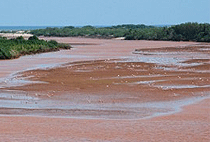

Furthermore, higher recruitment was recorded in August (2.63 ± 0.36) as compared to July (1.26 ± 0.04) when river discharge was 0.11m 3.s-1 and 0.14m 3.s-1, respectively. The Sabaki estuary, recorded a higher density (2.47 ± 0.07 ind -1) compared to Ramisi (1.60 ± 0.35 ind d -1). bengalensis was dominant, constituting (60%) of captures, followed by A. Comparison of recruitment among species suggested that, A. The sizes of glass eels collected were 1.49 ± 0.08 mm, while elvers were 1.94 ± 0.03 mm. All specimen were captured using fyke nets and none using the eel mops. Results showed that of the 53 juvenile anguillid eels captured, 86% were glass eels compared to elvers (13%). Specimen obtained from July to October, 2021, were identified, and meristic data recorded. This study evaluated occurrence and recruitment of juvenile anguillids into Kenyan estuaries using glass eel fyke nets and eel mops, deployed at the lower reaches of the Athi-Galana-Sabaki and Ramisi rivers.

Consequently, there is limited information on juvenile anguillid eels occurrence along the Kenyan rivers, hindering development of robust management strategies. Although juvenile anguillids recruitment into estuaries is critical to life cycle completion, their identification to species level solely on morphology is problematic, without the use of tail pigmentation. Anguillid eels are globally threatened by multiple stressors and several East African species are currently categorized as near threatened. bicolor, occur along East African rivers. Of the 19 globally known anguillid eel species, four Anguilla mossambica, A.
#Sabaki estuary professional
Mineral water during tour + All applicable Game Park entrance fees + Professional experienced driver-guide + Enjoy extensive Guided Bird watching Tour & Round trip transport from Malindi to your hotel.Glass eels, elvers, tail pigmentation, density, composition Abstract Sabaki River Estuary Malindi Bird Watching Day Trip Prices Include: Location of the Sabaki River Mouth, within this. Also renowned for rarities Sabaki River Estuary Malindi Bird Watching Day Trip Prices The estuary cover an area of about 6 km2 and measures approximately 200 km long from its entry into Chakama. This Malindi tour visits the Sabaki River Mouth – a huge estuary with thousands of waders and terns, in addition to pelicans.

The beaches are good nesting places for sea turtles. Sabaki River Estuary is rich in fish and crustaceans which have in turn supported fishing which is the main livelihood for the people of the area. Some of the species which have recorded sufficient numbers in the Sabaki estuary include pelicans, cormorants, herons, flamingoes, ducks, geese, waders, gulls, terns, and kingfishers. A total of 68 species have been recorded.

It hosts large visiting stocks of the Madagascar Pranticole and is also an important nesting, roosting, and feeding ground for gulls and terns. Sabaki River mouth is one of the Important Bird Areas (IBAs) in Kenya. Just north and south of the River Mouth are grassy sand dunes that conceal permanent or temporary water pools of freshwater. This has led to deepening of the estuary channels with the result. On the other hand, there has been a substantial reduction in both freshwater input and sediment supply into the Tana Delta. The state and size of the estuary vary seasonally depending on river flows. Sabaki estuary ensures reduced penetration of the semi-diurnal tidal wave into the estuary and seawater intrusion is restricted to 2.5 km of the estuary. Our half-day bird watching tour takes us to the Sabaki River Estuary which covers an area of about 6 square km and consists of sandbanks, mud banks, dunes, and seasonal and permanent freshwater pools, mangroves, and scrub. The largest river in Kenya is the Tana River. Sabaki River Mouth marks the point where Kenya’s second-largest river ( Athi-Galana-Sabaki River) empties into the ocean. Sabaki River Estuary or the Sabaki River Mouth is located within Malindi District of Coast Province and about 5 km’s North of Malindi town, between the Malindi-Mambrui road bridge and the sea. Sabaki River Estuary Malindi Bird Watching Day Trip: Just north of Malindi is one of the “must-see” places for birders, the Sabaki River Estuary.


 0 kommentar(er)
0 kommentar(er)
